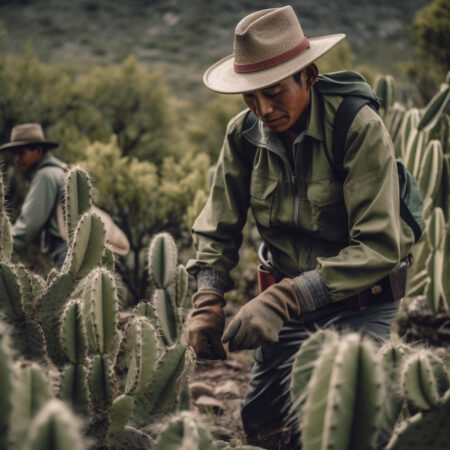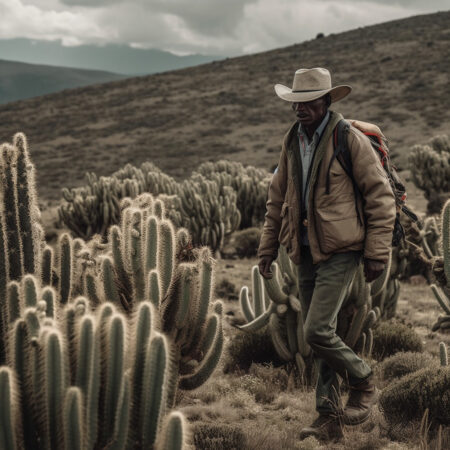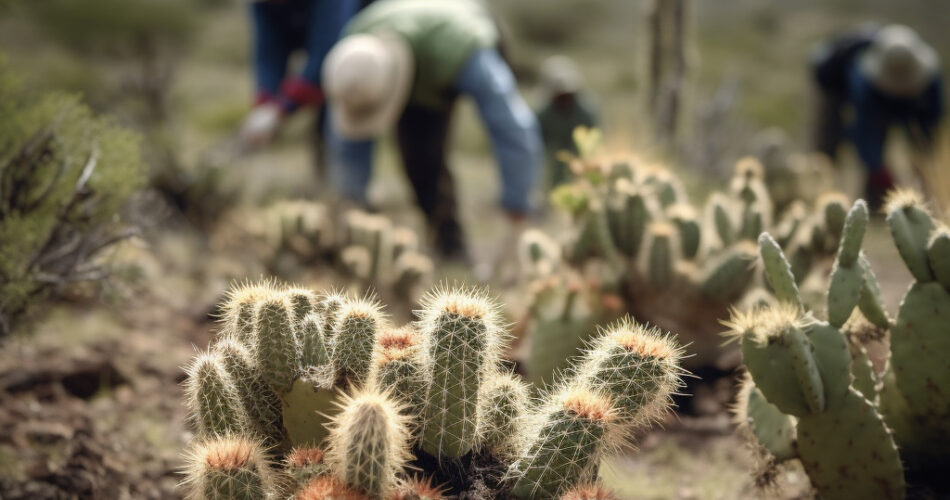Key Takeaways:
- Conservation efforts are crucial to protect cacti from habitat loss, invasive species, and illegal collecting.
- Cacti provide essential ecological functions and support diverse ecosystems.
- Cacti have cultural and historical significance, being used for food, medicine, and crafts.
- The Cactus and Succulent Society of America (CSSA) and the International Union for Conservation of Nature (IUCN) are influential organizations dedicated to cactus conservation.
- The Convention on International Trade in Endangered Species of Wild Fauna and Flora (CITES) regulates the trade of endangered cacti.
- Scientific research plays a crucial role in understanding cacti genetics, monitoring populations, and studying the impact of climate change.
- Habitat restoration, protected areas, and conservation breeding programs are vital for cactus conservation.
- Community engagement and education are important for long-term conservation success.
The Importance of Cactus Conservation
Cacti are a diverse and fascinating group of plants that play a crucial role in various ecosystems around the world. From the towering saguaros of the Sonoran Desert to the prickly pear cacti found in arid regions, these plants have adapted to survive in harsh conditions and have become iconic symbols of resilience.
1. Understanding the Threats to Cactus Species
Conservation efforts are vital to protect cacti from the various threats they face. One of the primary concerns is habitat loss due to urbanization, agriculture, and infrastructure development. As human activities expand, cacti habitats are being destroyed or fragmented, leading to a decline in populations and a loss of genetic diversity.
Invasive species also pose a significant threat to cacti. These non-native plants can outcompete native cacti for resources and disrupt natural ecosystems. Additionally, illegal collecting and poaching of cacti for ornamental trade further endanger certain species, particularly those with unique characteristics or rare forms.
2. Exploring the Ecological Significance of Cacti
Cacti provide essential ecological functions in their respective habitats. The unique adaptations of cacti, such as their ability to store water in their fleshy stems and spines that deter herbivores, contribute to the overall balance of ecosystems.
Many animals rely on cacti for food, water, and shelter. Birds, bats, and insects are attracted to the nectar and fruits of cacti, helping in pollination and seed dispersal. Additionally, cacti create microhabitats that support a variety of organisms, including reptiles, rodents, and even fungi.
3. The Cultural and Historical Value of Cacti
Cacti have played a significant role in the cultural and historical fabric of various societies. Indigenous communities have utilized cacti for centuries, using them as a source of food, medicine, and raw materials for crafts. Cacti also hold symbolic value in many cultures, representing endurance, protection, and adaptability.
From the agave plants used in the production of tequila to the medicinal uses of prickly pear cactus, these plants have shaped traditions and economies around the world. Preserving cacti ensures the continuity of these cultural practices and maintains their historical significance.

Influential International Organizations for Cactus Conservation
1. Cactus and Succulent Society of America (CSSA)
The Cactus and Succulent Society of America (CSSA) is a leading organization dedicated to the study and conservation of cacti and succulents. Founded in 1929, the CSSA promotes awareness, education, and research about these plants through various initiatives.
The CSSA organizes conferences, workshops, and exhibitions that bring together researchers, enthusiasts, and conservationists from around the world. They also publish the renowned Cactus and Succulent Journal, which features articles on plant conservation, cultivation, and new discoveries.
Through their Conservation Committee, the CSSA supports projects focused on the preservation of endangered cactus species and their habitats. They collaborate with local communities, governments, and other organizations to implement sustainable conservation strategies and initiatives.
2. International Union for Conservation of Nature (IUCN)
The International Union for Conservation of Nature (IUCN) is a global organization committed to assessing the conservation status of all known plant and animal species. Established in 1948, the IUCN maintains the authoritative Red List of Threatened Species, which categorizes species based on their risk of extinction.
The IUCN’s Cactus and Succulent Plant Specialist Group works to provide scientific expertise and guidance for cactus conservation efforts worldwide. They conduct assessments of cactus species, identify priority areas for conservation, and collaborate with governments and local communities to develop conservation action plans.
Furthermore, the IUCN actively advocates for policy changes and legislative measures to protect cacti and their habitats. They support research initiatives, promote sustainable land management practices, and raise awareness about the importance of cactus conservation.
3. Convention on International Trade in Endangered Species of Wild Fauna and Flora (CITES)
The Convention on International Trade in Endangered Species of Wild Fauna and Flora (CITES) is an international agreement established in 1975 to regulate the international trade of endangered plants and animals. Several cactus species are listed under CITES Appendix I, which prohibits their commercial trade.
CITES plays a crucial role in preventing the illegal trafficking of cacti, ensuring their continued survival in the wild. The convention allows countries to collaborate and enforce regulations to protect threatened cactus species from overharvesting and illegal trade.
Through the implementation of CITES, governments, and organizations work together to monitor and control the international trade of cacti, ensuring that it is sustainable and does not pose a threat to their populations.
The Role of Scientific Research in Cactus Conservation
1. Investigating the Genetics of Cacti
Genetic research is essential for understanding the diversity and evolutionary history of cacti. By studying the genetic makeup of different cactus species, scientists can identify distinct populations, determine their degree of relatedness, and assess their vulnerability to environmental changes.
Genetic studies also aid in identifying the sources of cactus populations for reintroduction and conservation breeding programs. By selecting individuals with high genetic diversity, these programs can help preserve the overall fitness and adaptability of cacti populations.
2. Monitoring and Documentation of Cactus Populations
Monitoring and documenting cactus populations provide crucial data for conservation efforts. Through systematic surveys and field studies, scientists can determine population sizes, assess trends in abundance, and identify potential threats to specific species.
Techniques such as remote sensing and satellite imagery are also used to monitor changes in cactus habitats and detect signs of degradation or loss. This information helps prioritize conservation actions and guide land management decisions.
3. Studying the Impact of Climate Change on Cacti
Climate change poses significant challenges to cactus populations worldwide. Rising temperatures, changing precipitation patterns, and increased frequency of extreme weather events can have detrimental effects on cacti and their habitats.
Scientific research plays a crucial role in understanding how climate change impacts cacti and developing strategies to mitigate these effects. Studies on cactus physiology, ecological interactions, and adaptation mechanisms provide valuable insights for conservation planning and the development of resilient management practices.

Conservation Efforts and Initiatives for Cacti
1. Habitat Restoration and Protection
Habitat restoration and protection are vital for ensuring the long-term survival of cacti. Efforts to restore degraded habitats, such as removing invasive species and implementing sustainable land management practices, help create suitable conditions for cacti to thrive.
Protected areas play a crucial role in conserving cacti and their ecosystems. National parks, reserves, and other designated areas provide legal protection and support the conservation of cactus species. Collaborative efforts between governments, local communities, and conservation organizations are necessary to establish and manage these protected areas effectively.
2. Conservation Breeding Programs for Endangered Cacti
Conservation breeding programs are essential for safeguarding endangered cacti and maintaining genetic diversity. These programs involve cultivating cacti in specialized facilities or botanical gardens to propagate them and reintroduce individuals into the wild.
By carefully selecting breeding pairs based on genetic diversity and adapting them to natural conditions, these programs aim to restore and establish self-sustaining populations. They also serve as insurance against the complete loss of a species by preserving a genetically diverse population in captivity.
3. Community Engagement and Education
Engaging local communities and raising awareness about the importance of cacti conservation is crucial for the long-term success of conservation efforts. Education programs, workshops, and outreach initiatives help foster a sense of stewardship and empower communities to become active partners in conservation.
Training local communities in sustainable harvesting practices and providing alternative livelihood options can reduce the pressure on wild cactus populations. Additionally, promoting eco-tourism centered around cacti can generate economic incentives for conservation while providing educational opportunities for visitors.
By involving communities in conservation initiatives, there is a greater chance of long-term sustainability and the preservation of cacti for future generations.
FAQ
Question: What are the threats to cactus species?
Habitat loss, invasive species, and illegal collecting are some of the primary threats to cactus species. Habitat loss occurs due to urbanization, agriculture, and infrastructure development, leading to a decline in populations and genetic diversity. Invasive species can outcompete native cacti and disrupt ecosystems. Illegal collecting and poaching also endanger certain species.
Question: What ecological functions do cacti provide?
Cacti provide essential ecological functions in their habitats. Their unique adaptations, such as water storage and spines that deter herbivores, contribute to the overall balance of ecosystems. Cacti serve as a food and water source for many animals, assist in pollination and seed dispersal, and create microhabitats that support a variety of organisms.
Question: What is the cultural and historical value of cacti?
Cacti have played a significant role in various cultures throughout history. Indigenous communities have utilized cacti for food, medicine, and crafts for centuries. Cacti hold symbolic value, representing endurance, protection, and adaptability. Preserving cacti ensures the continuity of cultural practices and maintains their historical significance.
Question: What is the Cactus and Succulent Society of America (CSSA)?
The CSSA is a leading organization dedicated to the study and conservation of cacti and succulents. It promotes awareness, education, and research about these plants through conferences, workshops, and publications. The CSSA supports conservation projects and collaborates with local communities and governments to implement sustainable strategies.
Question: What is the International Union for Conservation of Nature (IUCN)?
The IUCN is a global organization that assesses the conservation status of plant and animal species. It maintains the Red List of Threatened Species, which categorizes species based on their risk of extinction. The IUCN’s Cactus and Succulent Plant Specialist Group provides scientific expertise and guidance for conservation efforts.
Question: What is the Convention on International Trade in Endangered Species of Wild Fauna and Flora (CITES)?
CITES is an international agreement that regulates the trade of endangered plants and animals. Several cactus species are listed under CITES Appendix I, which prohibits their commercial trade. CITES prevents illegal trafficking and ensures the continued survival of threatened cacti in the wild.
Question: What is the role of scientific research in cactus conservation?
Scientific research plays a crucial role in understanding cactus genetics, monitoring populations, and studying the impact of climate change. Genetic studies aid in identifying populations for conservation breeding programs. Monitoring provides data for conservation efforts, and studying climate change effects guides mitigation strategies.
Question: What are some conservation efforts for cacti?
Habitat restoration, protected areas, and conservation breeding programs are essential for cactus conservation. Habitat restoration involves removing invasive species and implementing sustainable land management practices. Protected areas provide legal protection and support conservation. Conservation breeding programs aim to propagate endangered cacti and establish self-sustaining populations. Community engagement and education are also important for long-term conservation success.




Comments